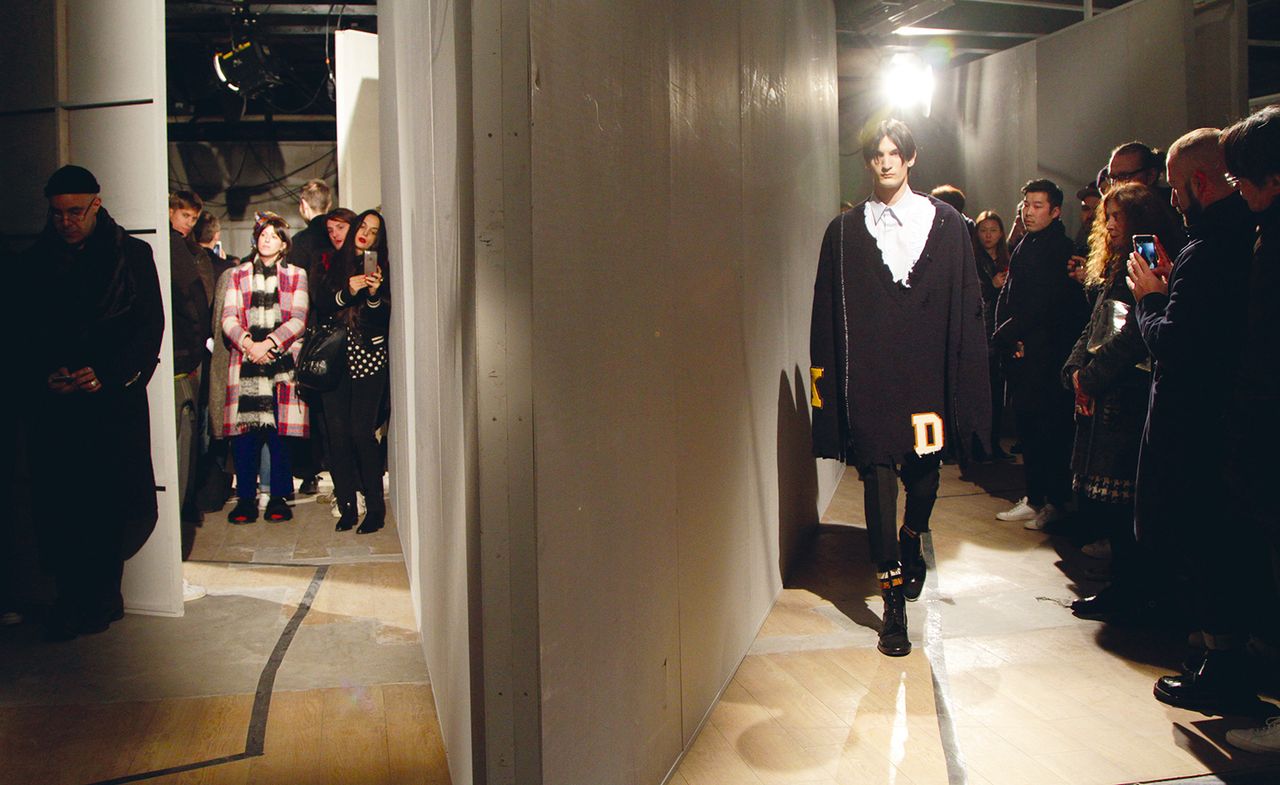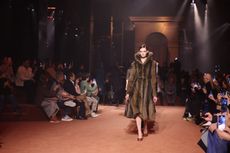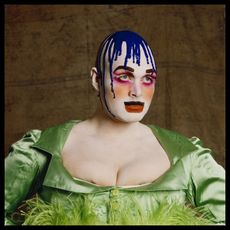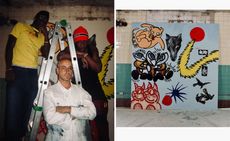Parade’s end: social media is reshaping the fashion show and set design is key to its future

There’s a revolution going on and it’s shattering the accepted form of the catwalk. We’ve seen the old New York-London-Milan-Paris March and September womenswear schedules fall apart, with shows spreading out, everywhere, across the year. There’s the arrival of the ‘see-now-buy-now’ show, aimed directly at the consumer, and then the creeping sense of the obsolescence of the traditional gatekeepers to taste and information. All this is openly being described as chaos in the industry.
But as the pillars of the inner temples of fashionopolis tremble, what’s rarely said is that this is an industrial revolution, caused by the incoming of a machine. What the internal combustion engine was to the horse and cart, the camera phone is to the ossified 20th-century catwalk show.
It’s a roilingly surreal quake of a time to be both watching and making fashion shows. Alexandre de Betak, whose company Bureau Betak has long been at the forefront of show production, says that this revolution, running at the speed of an Instagram or Snapchat feed, is ‘drastic. Now you are thinking about images that will look good in a square, or in a ten-second video.’ Thierry Dreyfus – another of the industry’s go-to set designers and artistic director of Paris-based Eyesight – points out that this intersection of technology and commerce has always driven the design and mechanics of the catwalk show. ‘The catwalk used to be a very private place. People weren’t even allowed to draw. Then photographers arrived but weren’t seen as crucial. The best seats were at the front, because you had eye contact with the models, but the photographers were kept to the side,’ he says. ‘Then magazines started to request catwalk shots, so the photographers were moved to the front, but placed behind the audience.
The phalanx of press photographers was eventually given prime position, but then the smartphone-carrying bloggers and vloggers, leveraging the power and influence of social media, created new dilemmas for the set designer. ‘The problem then was that everyone was getting the same pictures,’ says Dreyfus. He designed Raf Simons’ menswear A/W16 show in Paris and did away with seating and allowed models to meander amongst guests through a maze-like set. ‘The models were 20cm in front of you,’ he says. And, crucially, every iPhone-armed ‘influencer’ had something a little different to feed their followers. Dreyfus notes, though, that for all this free-form fun, they still had to provide a less cluttered, more ‘pure space’ where photographers could get cleaner shots. The fashion show now has to be many things to many people.
As a fashion journalist who’s been documenting this game for 30 years, I know the inward effect these changes are having on my brain – and the outward effects on a catwalk culture that is morphing, bending, atomising, exploding into new shapes. My professional tools used to be pen and notebook, but now there’s an iPhone 6 Plus in my kit. I still draw and write reviews for Voguerunway.com as ever, but this I know: that new visual-communication device has both extended and altered my way of seeing and evaluating the worth and meaning of what’s in front of me.
Now, it’s a question of roaming, with a square-eyed Instagram-vision, on the hunt for beautiful, funny, breathtaking, surprising, delightful things – close-ups on accessories, zoom-ins on the incredible stitching and beading on clothes. I take snaps of how we got there, and sometimes just lovely, interesting faces. This is the fun everyone’s having at shows now.
It feels (maybe delusionally) like a different kind of creativity – narrative, panorama and detail are the content-fuel for the newfangled machinery, and the response to it is changing the whole nature of the fashion ‘performance’, and the skills and imagination needed to produce it. Which is why ‘experiential’ is the new buzzword. Chanel, Christian Dior, Louis Vuitton, Dolce & Gabbana and Gucci are at the forefront of this shift. In the old days, the highest aspiration for a designer was to create, through clothes and catwalk, a suspension of disbelief that could emotionally transport the audience. When Alexander McQueen, Hussein Chalayan, John Galliano, Jean Paul Gaultier, Christian Lacroix, Helmut Lang and Martin Margiela did that, it was as delightfully, joyously, intellectually unforgettable as a fashion experience could get. Now the business of audience ‘transportation’ has become the actual mass airlifting of models, crew and guests to exotic locations. Over the summer months, Chanel tripped off to Havana, Louis Vuitton to Rio de Janeiro, Christian Dior to Blenheim Palace on the Orient Express, Gucci to Westminster Abbey, Dolce & Gabbana to Naples. I’ve almost lost count of the places I’ve gone for shows over the past couple of years: Seoul, Singapore, Dubai, Scotland, Cannes, Rome, Portofino.
The reasons behind the competition are explicit: beautiful landmarks, days of feasting, sightseeing and sunbathing, hospitality for local and global clients, the generation of zillions of brand-mentioning digital images. Etienne Russo, another of the set design A-list, says that the arrival of the ‘see-now- buy-now’ shows is also having a dramatic effect. ‘We did the Dior Homme show in Paris in January for the usual audience of press, buyers and bloggers. And then we did one in China a few months later where the clothes were actually available to buy soon after,’ he says. ‘The show had the same essence, but the audience is much bigger and mostly consumers, so you have to rethink it. You have to make it more entertaining. There is a dinner and a party. It is much more of a moment with the brand.’
The accepted model – shows of thin white girls filing up and down catwalks against interchangeable backgrounds – had become monotonous and I love seeing that questioned and dismantled. A healthy part of this challenge to the status quo is the new diversity in terms of race, shape, age, character; the casting of non-professional models and friends by designers like Hood By Air, Marques’ Almeida, Gosha Rubchinskiy and Undercover. Social media is playing a crucial two-way role in that part of the revolution as well. On the one hand, designers such as Vetements find people to walk in their shows on Facebook and Instagram; on the other, when young people are enraged by the lack of representation they see in shows, the anger against a brand can spread uncontrollably. That, too, is a massive transformative factor in the way shows are being reframed.
De Betak, who started out creating the scenography for Hussein Chalayan’s early performances in the 1990s, has a cool-headed and optimistic perspective on all this change. ‘Waves in the way things are done are normal. There was theatricality when I started and then everybody wanted minimal – everything against a white background to fit into the template of Style.com,’ he says. ‘But the good thing is that everything is going to become non-uniform. There will be more diversity.’
Significantly, Bureau Betak bills itself as a producer of ‘multi-sensory events’. Insight into the audience’s feelings is a crucial de Betak strength, as is an instinct for what will leave a ‘long tail’ after the Insta-immediate flurry. His recent plot for Berluti in Paris was an open-air, join-in sports hour, turning the audience happily into participants – a rare feat for an army of hard-to-impress professionals inured to enduring the lockstep schedule of appointments and runway shows that men’s fashion weeks have become. Berluti sells shoes, and they were seen. The product-communication job was done, in the instant. Then, but even better, the simultaneous surprise: creating a humanising halo around the brand.
It’s the task of all intelligent creatives involved in communicating fashion to humanise a regimented system, which had ended up only producing numbness. As just one of the people immersed in the adrenalin-soused, instantly reactive, over-stimulated, constantly connected, digital world of fashion, I often have flashes of not knowing in which direction to look or what to think or feel about it. The worst conclusion of all would be: nothing. That is not happening yet. Here’s a thought, though: if pictures of clothes and accessories are becoming a sort of sprinkling of garnish on top of an event, what is it that actually sells them?
As originally featured in the September 2016 issue of Wallpaper* (W*210)
INFORMATION
Photogrphy: Eyesight/ Mathias Wendzinski
Wallpaper* Newsletter
Receive our daily digest of inspiration, escapism and design stories from around the world direct to your inbox.
-
 Fendi celebrates 100 years with all-out runway show at its new Milan HQ
Fendi celebrates 100 years with all-out runway show at its new Milan HQIn the wake of Kim Jones’ departure, Silvia Venturini Fendi took the reins for a special co-ed A/W 2025 collection marking the house’s centenary, unveiling it as the first act of celebrations within Fendi’s expansive new headquarters in Milan
By Jack Moss Published
-
 ‘Leigh Bowery!’ at Tate Modern: 1980s alt-glamour, club culture and rebellion
‘Leigh Bowery!’ at Tate Modern: 1980s alt-glamour, club culture and rebellionThe new Leigh Bowery exhibition in London is a dazzling, sequin-drenched look back at the 1980s, through the life of one of its brightest stars
By Amah-Rose Abrams Published
-
 Inside the unexpected collaboration between Marni’s Francesco Risso and artists Slawn and Soldier
Inside the unexpected collaboration between Marni’s Francesco Risso and artists Slawn and SoldierNew exhibition ‘The Pink Sun’ will take place at Francesco Risso’s palazzo in Milan in collaboration with Saatchi Yates, opening after the Marni show today, 26 February
By Hannah Silver Published